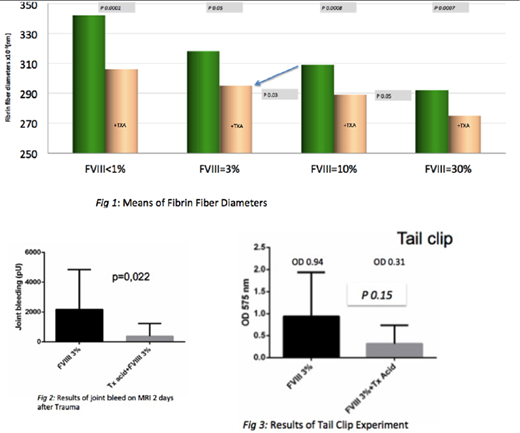Abstract
Introduction
Hemophilia is an X linked disorder characterized by an increased tendency to spontaneous bleeding resulting from profound compromise of the hemostatic response with delayed development of a clot and the formation of clots that are vulnerable to fibrinolysis. Optimization of clot stability by adding TXA to low concentrations of factor concentrates may be a way to improve prophylaxis in patients with severe hemophilia (sH) without substantially increasing the cost or the burden of more frequent infusions.
Aims
We proposed to study whether hemostasis is improved with the addition of TXA to low FVIII plasma concentrations (equivalent to trough levels in prophylactic setting). We specifically studied in vitro the clot stability in patients with sHA; and in vivo the hemostatic response to trauma-induced joint bleed and tail clip in FVIII knock-out (KO) mice.
Methods
After obtaining informed consent, blood samples of 12 adults with sHA were spiked in vitro to achieve final concentrations (FC) of 0-3-10 and 30 IU/dL of FVIII, then studied with and without TXA at FC 0.1mg/ml. Whole blood (WB) was assessed with ROTEM performed after addition of tPA in 6 patients. Thrombin generation (TG) was measured in plasma (PL) of 6 other patients. Clots obtained from TG were examined under electron microscopy (EM) to evaluate the quality of fibrin clot structure. Diameters of randomly selected 100 fibrin fibers were measured in each clot.
In animal studies, 13 FVIII KO mice were given FVIII to a plasma concentration of 3 IU/dL to mimic trough FVIII levels in prophylactic setting; 7 were also infused with TXA (FC 0.1mg/ml). 10 minutes after infusion, joint bleeding was induced by knee puncture using a standardized protocol. 2 days post trauma, MRI was done and the joint bleed (surface of hyper signal into the joint) was compared between the groups with and w/o TXA.
10 other FVIII KO mice were infused with 3 IU/dL rFVIII, of which 5 were also infused with TXA (FC 0.1mg/ml). 10 minutes after infusion, the extremity of the tail was cut at 2mm, and then immersed in pre-heated water-filled tube at 37°C. Blood was collected during 10 minutes. After lysis of erythrocytes, the amount of hemoglobin in collected blood was measured using spectrophotometry; means of optical density (OD) were compared between the 2 groups.
Results
A dose dependent improvement of TG was observed after adding FVIII alone (p=0.024). As expected, the addition of TXA had no effect on TG capcity. Fibrin fiber diameters were significantly decreased with TXA+FVIII compared to FVIII alone (results shown in fig1), suggesting a stronger fibrin network, as thin fibrin fibers are characteristic of a robust fibrin mesh. Surprisingly, ROTEM was fully normalized after addition of TXA only, with no exogenous FVIII.
In FVIII KO mice, the addition of TXA to 3 IU/dL rFVIII significantly decreased joint bleeding compared to 3 IU/dL rFVIII alone (p=0.022) (fig2).With the tail clip experiment, the addition of TXA to 3 IU/dLFVIII showed a trend toward improved bleeding when compared to 3 IU/dLFVIII alone; with means of OD±SEM 0,31±0,19 and 0,94±0,45 respectively, but did not reach statistical significance (p=0,15) (fig3).
Conclusion
Our in vitro and in vivo results suggest a potential benefit of TXA when used in combination with FVIII in prophylactic setting.
No relevant conflicts of interest to declare.
Author notes
Asterisk with author names denotes non-ASH members.


